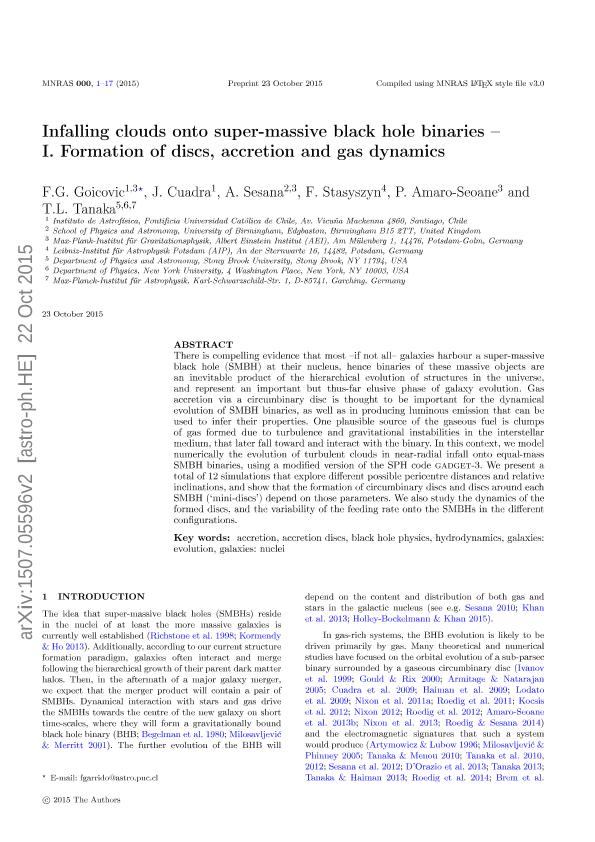Mostrar el registro sencillo del ítem
dc.contributor.author
Goicovic, Felipe
dc.contributor.author
Cuadra, Jorge
dc.contributor.author
Sesana, A.
dc.contributor.author
Stasyszyn, Federico Andres

dc.contributor.author
Amaro-Seoane, P.
dc.contributor.author
Tanaka, T. L.
dc.date.available
2023-01-05T20:15:20Z
dc.date.issued
2016-01
dc.identifier.citation
Goicovic, Felipe; Cuadra, Jorge; Sesana, A.; Stasyszyn, Federico Andres; Amaro-Seoane, P.; et al.; Infalling clouds on to supermassive black hole binaries - I. Formation of discs, accretion and gas dynamics; Wiley Blackwell Publishing, Inc; Monthly Notices of the Royal Astronomical Society; 455; 2; 1-2016; 1989-2003
dc.identifier.issn
0035-8711
dc.identifier.uri
http://hdl.handle.net/11336/183604
dc.description.abstract
There is compelling evidence that most - if not all - galaxies harbour a supermassive black hole (SMBH) at their nucleus; hence binaries of these massive objects are an inevitable product of the hierarchical evolution of structures in the Universe, and represent an important but thus-far elusive phase of galaxy evolution. Gas accretion via a circumbinary disc is thought to be important for the dynamical evolution of SMBH binaries, as well as in producing luminous emission that can be used to infer their properties. One plausible source of the gaseous fuel is clumps of gas formed due to turbulence and gravitational instabilities in the interstellar medium, that later fall towards and interact with the binary. In this context, we model numerically the evolution of turbulent clouds in near-radial infall on to equal-mass SMBH binaries, using a modified version of the SPH (smoothed particle hydrodynamics) code GADGET-3. We present a total of 12 simulations that explore different possible pericentre distances and relative inclinations, and show that the formation of circumbinary discs and discs around each SMBH ('mini-discs') depend on those parameters. We also study the dynamics of the formed discs, and the variability of the feeding rate on to the SMBHs in the different configurations.
dc.format
application/pdf
dc.language.iso
eng
dc.publisher
Wiley Blackwell Publishing, Inc

dc.rights
info:eu-repo/semantics/openAccess
dc.rights.uri
https://creativecommons.org/licenses/by-nc-sa/2.5/ar/
dc.subject
ACCRETION
dc.subject
ACCRETION DISCS
dc.subject
BLACK HOLE PHYSICS
dc.subject
GALAXIES: EVOLUTION
dc.subject
GALAXIES: NUCLEI
dc.subject
HYDRODYNAMICS
dc.subject.classification
Astronomía

dc.subject.classification
Ciencias Físicas

dc.subject.classification
CIENCIAS NATURALES Y EXACTAS

dc.title
Infalling clouds on to supermassive black hole binaries - I. Formation of discs, accretion and gas dynamics
dc.type
info:eu-repo/semantics/article
dc.type
info:ar-repo/semantics/artículo
dc.type
info:eu-repo/semantics/publishedVersion
dc.date.updated
2022-12-06T17:26:50Z
dc.identifier.eissn
1365-2966
dc.journal.volume
455
dc.journal.number
2
dc.journal.pagination
1989-2003
dc.journal.pais
Reino Unido

dc.journal.ciudad
Londres
dc.description.fil
Fil: Goicovic, Felipe. Pontificia Universidad Catolica de Chile. Facultad de Física. Departamento de Física; Chile. Max-planck-institut Für Gravitationsphysik; Alemania
dc.description.fil
Fil: Cuadra, Jorge. Pontificia Universidad Catolica de Chile. Facultad de Física. Departamento de Física; Chile
dc.description.fil
Fil: Sesana, A.. University of Birmingham. School of Physics and Astronomy; Reino Unido. Max-planck-institut Für Gravitationsphysik; Alemania
dc.description.fil
Fil: Stasyszyn, Federico Andres. Max-planck Institut Für Gravitationphysick; Alemania. Consejo Nacional de Investigaciones Científicas y Técnicas. Centro Científico Tecnológico Conicet - Córdoba. Instituto de Astronomía Teórica y Experimental. Universidad Nacional de Córdoba. Observatorio Astronómico de Córdoba. Instituto de Astronomía Teórica y Experimental; Argentina
dc.description.fil
Fil: Amaro-Seoane, P.. Gobierno de la República Federal de Alemania. Max Planck Institut für Astrophysik; Alemania
dc.description.fil
Fil: Tanaka, T. L.. Gobierno de la República Federal de Alemania. Max Planck Institut für Astrophysik; Alemania. Washington State University; Estados Unidos. State University of New York. Stony Brook University; Estados Unidos
dc.journal.title
Monthly Notices of the Royal Astronomical Society

dc.relation.alternativeid
info:eu-repo/semantics/altIdentifier/doi/http://dx.doi.org/10.1093/mnras/stv2470
dc.relation.alternativeid
info:eu-repo/semantics/altIdentifier/url/https://academic.oup.com/mnras/article/455/2/1989/1122366
Archivos asociados
